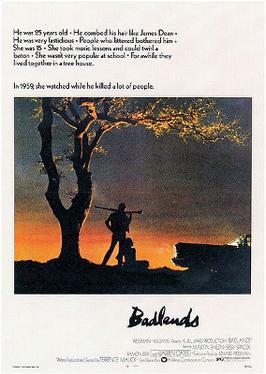
Badlands is a 1973 American neo-noir period crime drama film written, produced and directed by Terrence Malick, in his directorial debut. The film stars Martin Sheen and Sissy Spacek, and follows Holly Sargis (Spacek), a 15-year old who goes on a killing spree with her partner, Kit Carruthers (Sheen). The film also stars Warren Oates and Ramon Bieri. While the story is fictional, it is loosely based on the real-life murder spree of Charles Starkweather and his girlfriend, Caril Ann Fugate, in 1958.
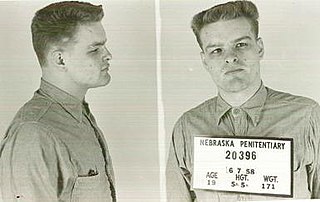
Charles Raymond Starkweather was an American spree killer who murdered eleven people in Nebraska and Wyoming between November 1957 and January 1958, when he was nineteen years old. He killed ten of his victims between January 21 and January 29, 1958, the date of his arrest. During his spree in 1958, Starkweather was accompanied by his fourteen-year-old girlfriend, Caril Ann Fugate.

Distant Drums is a 1951 American Florida Western film directed by Raoul Walsh and starring Gary Cooper. It is set during the Second Seminole War in the 1840s, with Cooper playing an Army captain who successfully destroys a fort held by Spanish gunrunners and is pursued into the Everglades by a large group of Seminoles. The fort used in the film was the historic Castillo de San Marcos in St. Augustine, Florida, and most of the principal photography was shot on location in Florida.

Caril Ann Fugate is the youngest female in United States history to have been tried and convicted of first-degree murder. She was the adolescent girlfriend of spree killer Charles Starkweather, being just 14 years old when his murders took place in 1958. She was convicted as his accomplice and sentenced to life imprisonment. In 1976, she was paroled after serving 18 years.
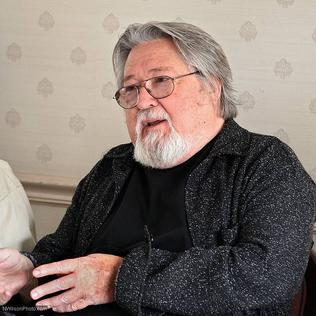
László KovácsASC was a Hungarian-American cinematographer who was influential in the development of American New Wave films in the 1970s, collaborating with directors including Peter Bogdanovich, Richard Rush, Dennis Hopper, Norman Jewison, and Martin Scorsese. Known for his work on Easy Rider (1969) and Five Easy Pieces (1970), Kovács was the recipient of numerous awards, including three Lifetime Achievement Awards. He was an active member of the American Society of Cinematographers and was a member of the organization's board of directors.

Blow Out is a 1981 American neo-noir mystery thriller film written and directed by Brian De Palma. The film stars John Travolta as Jack Terry, a movie sound effects technician from Philadelphia who, while recording sounds for a low-budget slasher film, unintentionally captures audio evidence of an assassination involving a presidential hopeful. Nancy Allen stars as Sally Bedina, a young woman involved in the crime. The supporting cast includes John Lithgow and Dennis Franz. The film's tagline in advertisements was, "Murder has a sound all of its own".

Albert Victor Adamson Jr. was an American filmmaker and actor known as a prolific director of B-grade horror and exploitation films throughout the 1960s and 1970s.
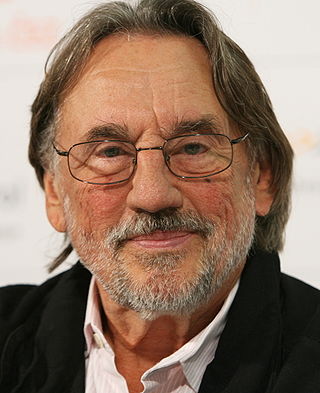
Vilmos Zsigmond was a Hungarian-American cinematographer. His work in cinematography helped shape the look of American movies in the 1970s, making him one of the leading figures in the American New Wave movement.
"Nebraska" is the title song of Bruce Springsteen's 1982 solo album. The stark, moody composition sets the tone for the LP, the content of which consists mostly of songs about criminals and desperate people, accompanied only by acoustic guitar and harmonica. The song has been covered by other artists, including Steve Earle, Chrissie Hynde, and Aoife O'Donovan.
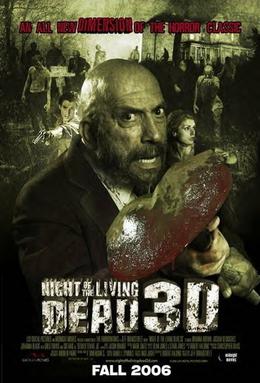
Night of the Living Dead 3D or Night of the Living DE3D is a 2006 horror film made in 3D. It is the second remake of the 1968 horror classic Night of the Living Dead. The first remake was released in 1990 and was directed by Tom Savini from a revised screenplay by George A. Romero. Unlike the first remake, no one involved with the original is involved with this version. The original film was never properly copyrighted, and so it has fallen into the public domain, making this remake possible with no permission from the original's creators.

Man's Best Friend is a 1993 American science fiction horror film, directed and written by John Lafia. It stars Ally Sheedy, Lance Henriksen, Robert Costanzo, Frederic Lehne, John Cassini, and J. D. Daniels.

Night Screams is a 1987 American slasher film directed by Allen Plone.

Cult of the Cobra is a 1955 American black-and-white horror film from Universal-International Pictures, produced by Howard Pine, directed by Francis D. Lyon, that stars Faith Domergue, Richard Long, Kathleen Hughes, Marshall Thompson, Jack Kelly, William Reynolds, and David Janssen. The film was released as a double feature with Revenge of the Creature.
József S. Mikó Joseph Miko was a cinematographer in Hungary when the 1956 revolution against the Russian occupation broke out. Miko grabbed the opportunity to film the revolution in hopes of getting the films out of Hungary so the rest of the world could see the brutality of the Soviet Union. The Soviet government found out about his activities and they wanted him and the films he shot. Joseph Miko with wife Eva and Joe jr. fled the country to avoid capture, imprisonment and possible execution.

No Subtitles Necessary: Laszlo & Vilmos is a 2008 American documentary film written and directed by James Chressanthis.
Gyula Pados is a Hungarian cinematographer. He is best known for his collaborations with director Wes Ball on the films Maze Runner: The Scorch Trials, Maze Runner: The Death Cure, and Kingdom of the Planet of the Apes.

Six Dance Lessons in Six Weeks is a 2014 Hungarian-American comedy-drama film starring Gena Rowlands and Cheyenne Jackson alongside a supporting cast including Jacki Weaver, Rita Moreno, Julian Sands and Anthony Zerbe. The film was adapted by Richard Alfieri from his play of the same name and directed by Arthur Allan Seidelman. It was the final film of director of photography Vilmos Zsigmond, who died two years after the film's release in 2016 and last film of Rowlands before she retired in 2015, followed by her death in 2024.

Global Cinematography Institute (GCI) is a film school that teaches new emerging technologies and concepts in the field of cinematography. Founded by Yuri Neyman, ASC and Vilmos Zsigmond, ASC, the Global Cinematography Institute aims to prepare filmmakers to take advantage of on-going advances in digital and virtual cinematography technologies through a curriculum known as Expanded Cinematography.

The House That Vanished is a 1973 British exploitation horror film directed by José Ramón Larraz, written by Derek Ford, and starring Andrea Allan, Karl Lanchbury and Judy Matheson. Its plot follows a young fashion model who witnesses a murder in an abandoned house in the woods, but is unable to relocate it after reporting the crime to police.
















